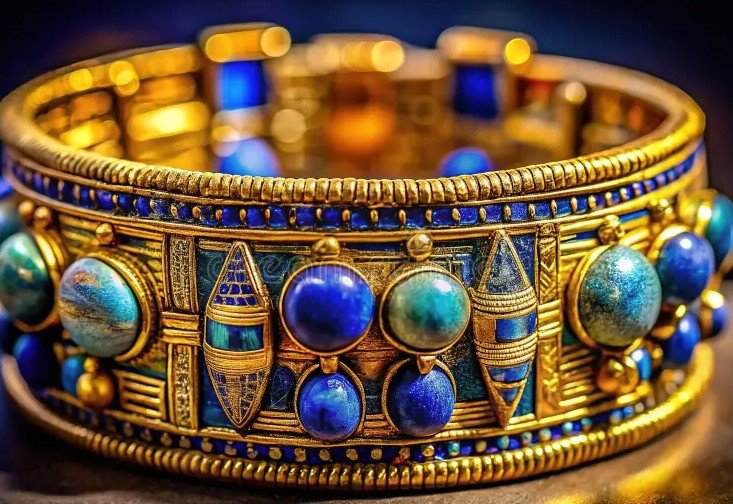Egyptians are furious after a 3,000-year-old gold bracelet from Pharaoh Amenemope was stolen from Cairo’s Egyptian Museum and melted down for scrap. The theft happened on September 9, 2025, during preparations for an international exhibit, leading to quick arrests and calls for better security.
The Shocking Theft at Cairo’s Iconic Museum
Museum staff discovered the bracelet missing while packing artifacts for a show in Italy. Officials say a restoration specialist took it from a lab without cameras, passing it to a silver shop owner in Cairo’s Sayyeda Zainab area.
The bracelet vanished amid routine work, sparking an immediate probe. Tourism and Antiquities Minister Sherif Fathy called out poor procedures at the museum, which houses treasures from ancient Egypt.
This incident echoes past security lapses in global museums, where priceless items have slipped away due to insider help.
Details of the Ancient Artifact
The bracelet belonged to Pharaoh Amenemope, who ruled from 993 to 984 BC during Egypt’s 21st Dynasty. Made of pure gold with lapis lazuli beads, it weighed about 600 grams and held huge historical value.

Experts value such pieces at millions due to their age and craftsmanship. Yet thieves sold it for just $3,700, then resold for $4,000 before melting.
- Material Composition: Gold band with spherical lapis lazuli beads.
- Historical Significance: Linked to a pharaoh’s reign over 3,000 years ago.
- Discovery Site: Originally from Tanis, an ancient city.
This loss destroys a direct link to Egypt’s past, much like other melted artifacts that rob future generations.
Amenemope’s era saw political shifts, and items like this bracelet offer clues to royal life. Similar pieces have survived in museums worldwide, but this one met a tragic end.
Arrests and Investigation Updates
Authorities arrested four people, including the museum worker who confessed. The group included a silver dealer and gold workshop owners who melted the bracelet into jewelry.
Prosecutors seized the money from the sales, totaling around $4,000. The interior ministry shared details on September 19, 2025, after confessions.
Investigators traced the chain: from lab to shop, then to a foundry. No cameras in the lab helped the theft, but quick police work led to arrests.
This case highlights how insider knowledge can bypass security. Officials promise a full review to prevent repeats.
Public Anger and Social Media Backlash
Egyptians expressed rage online and in streets, calling the act a crime against heritage. Social media posts mourned the loss, with many demanding accountability from museum leaders.
One viral post compared it to losing a family heirloom, fueling debates on protecting national treasures. Protests gathered outside the museum, urging reforms.
The outrage ties into broader frustrations over artifact smuggling, a problem Egypt has fought for years. Recent laws aim to curb black market sales, but this theft shows gaps remain.
| Key Reactions | Details |
|---|---|
| Social Media Outcry | Thousands of posts on platforms like X, with hashtags like #SaveEgyptHeritage trending. |
| Public Protests | Small groups demonstrated in Cairo, calling for minister’s resignation. |
| Expert Opinions | Archaeologists warn this could scare away tourists and donors. |
| Government Response | Promises of new security measures, including cameras in all labs. |
This wave of anger reflects deep national pride in Egypt’s ancient history.
Broader Implications for Museum Security
The meltdown raises questions about safeguarding artifacts globally. Egypt has lost items before, like in 2011 unrest when thieves hit the museum.
Experts suggest better tech, like AI monitoring and staff vetting, to protect sites. This theft could lead to policy changes, affecting how museums worldwide handle valuables.
Tourism, a key economy driver, might suffer if visitors doubt safety. In 2024, Egypt welcomed over 15 million tourists, drawn by pharaonic wonders.
Logical steps include international alerts for stolen goods, as seen in past cases like the 2023 recovery of a stolen statue.
Historical Context and Related Events
Pharaoh Amenemope’s rule came during a time of decline after the New Kingdom’s glory. His tomb in Tanis yielded treasures, including this bracelet, found in the 1940s.
Recent events, like the 2025 opening of the Grand Egyptian Museum, spotlight preservation needs. That project, delayed but now thriving, aims to house artifacts securely.
Compare this to the 2022 theft of Roman coins in Italy, recovered intact. Melting destroys evidence, making recovery impossible.
Egypt pushes global pacts to fight trafficking, with UNESCO aiding since 1970. This incident may speed up those efforts.
What do you think about this loss of history? Share your thoughts in the comments and spread the word to raise awareness about protecting cultural treasures.
